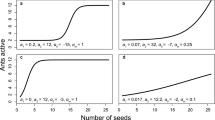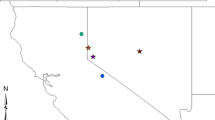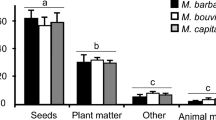Summary
We investigated individual foraging components of the western harvester ant,Pogonomyrmex occidentalis, in the native seed background of a shrub-steppe environment. Our study identified factors affecting foraging movements and seed selection by individual ants. Some assumptions and predictions of central-place foraging theory and a correlated random walk were evaluated for individual foragers. Results showed that ant size was only weakly correlated with the seed sizes harvested; seed size was a more important constraint than a predictor of seed selection. Individual ants spent more time in localized search behavior than traveling between search areas and nests.P. occidentalis foragers encountered seeds randomly with respect to time, and handled a mean of 1.7 seeds/trip. A correlation of increased search effort with greater travel distances was consistent with central-place foraging theory but, contrary to it, search and travel effort were not associated with energetic reward.
Individual ants exhibited fidelity in both search site and native seed species. Spatial analyses of foraging movements showed a highly oriented travel path while running, and an area-restricted path while searching. Searching ants moved in a manner consistent with a correlated random walk. The deterministic component of patch fidelity and the stochastic component of search may override energetic foraging decisions in individualP. occidentalis ants.
Similar content being viewed by others
References
Batschelet, E., 1981.Circular Statistics in Biology. Academic Press, New York, 370 pp.
Bernstein, R. A., 1975. Foraging strategies of ants in response to variable food density.Ecology 56:213–219.
Briese, D. T. and B. J. Macauley, 1981. Food collection within an ant community in semi-arid Australia, with special reference to seed harvesters.Aust. J. Ecol 6:1–19.
Cain, M. L., 1989. The analysis of angular data in ecological field studies.Ecology 70:1540–1542.
Crist, T. O., 1990.Granivory in a shrub-steppe ecosystem: interactions of harvester ant foraging and native seeds.PhD thesis. Utah State University, Logan.
Crist, T. O. and J. A. MacMahon, 1991. Foraging patterns ofPogonomyrmex occidentalis (Hymenoptera: Formicidae) in a shrub-steppe ecosystem: the roles of temperature, trunk trails, and seed resources.Environ. Entomol. 20:265–275.
Davidson, D. W., 1978. Experimental tests of the optimal diet in two social insects.Behav. Ecol. Sociobiol 4:35–41.
Deneubourg, J.-L., S. Aron, S. Goss and J. M. Pasteels, 1990. The self-organizing exploratory pattern of the argentine ant.J. Insect Behav. 3:159–168.
De Vita, J., 1979. Mechanisms of interference and foraging among colonies of the harvester antPogonomyrmex californiens in the Mojave Desert.Ecology 60:729–737.
Eddy, T. A., 1970.Foraging behavior of the western harvester ant, Pogonomyrmex occidentalis, (Hymenoptera: Formicidae) in Kansas.PhD thesis. Kansas State University, Manhattan.
Fewell, J. H., 1988. Energetic and time costs of foraging in harvester ants,Pogonomyrmex occidentalis.Behav. Ecol. Sociobiol. 22:401–408.
Fewell, J. H., 1990. Directional fidelity as a foraging constraint in the western harvester ant,Pogonomyrmex occidentalis.Oecologia 82:45–51.
Fresneau, D., 1985. Individual foraging and path fidelity in a ponerine ant.Ins. Soc. 32:109–116.
Gordon, D. M., 1984. Species-specific patterns in the social activities of harvester ant colonies (Pogonomyrmex)Ins. Soc. 31:74–86.
Hahn, M. and U. Maschwitz, 1985. Foraging strategies and recruitment behaviour in the European harveser antMessor rufitarsis (F.).Oecologia (Berl.) 68:45–51.
Harkness, R. D. and N. G. Maroudas, 1985. Central place foraging by an ant (Cataglyphis bicolor Fab.): a model of searching.Anim. Behav. 33:916–928.
Herbers, J. M., 1981. Reliability theory and foraging by ants.J. theor. Biol. 89:175–189.
Hobbs, R. J., 1985. Harvester ant foraging and plant species distribution in annual grassland.Oecologia (Berl.) 67:519–523.
Hölldobler, B., 1976. Recruitment behavior, home range orientation and territoriality in harvester ants,Pogonomyrmex.Behav. Ecol. Sociobiol. 1:1–44.
Hölldobler, B. and E. O. Wilson, 1970. Recruitment trails in the harvester antPogonomyrmex badius.Psyche 77:385–399.
Hölldobler, B. and E. O. Wilson, 1990.The Ants. The Belknap Press of Harvard University Press, Cambridge, Massachusetts, 732 pp.
Jander, R., 1982. Random and systematic search in foraging insects. In:Biology of Social Insects (M. D. Breed, C. D. Michener and H. E. Evans, Eds.), Westview Press, Boulder, Colorado, pp 20–31.
Jorgensen, C. D. and S. D. Porter, 1982. Foraging behavior ofPogonomyrmex owyheei in southeast Idaho.Environ. Entomol.11:381–384.
Kareiva, P. M. and N. Shigesada, 1983. Analyzing insect movement as a correlated random walk.Oecologia (Berl.) 56:234–238.
Kelrick, M. I., J. A. MacMahon, R. R. Parmenter and D. V. Sisson, 1986. Native seed preferences of shrub-steppe rodents, birds and ants: the relationships of seed attributes and seed use.Oecologia (Berl.) 68:327–337.
MacMahon, J. A. and F. H. Wagner, 1985. The Mojave, Sonoran and Chihuahuan Deserts of North America. In:Hot Deserts and Arid Shrublands, Vol. 12A, Ecosystems of the World (M. Evenari and I. Noy-Meir, Eds.), Elsevier Publishers, Amsterdam, pp. 105–202.
McCulloch, C. E. and M. L. Cain, 1989. Analyzing discrete movement data as a correlated random walk.Ecology 70:383–388.
Onoyama, K. and T. Abe, 1982. Foraging behavior of the harvester antMessor aciculatus in relation to the amount and distribution of food.Jap. J. Ecol. 32:383–393.
Orians, G. H. and N. E. Pearson, 1979. On the theory of central place foraging. In:Analysis of Ecological Systems (D. J. Horn, G. R. Stairs and R. D. Mitchells, Eds.), Ohio State University Press, Columbus, pp. 155–177.
Oster, G. F. and E. O. Wilson, 1978.Caste and Ecology in the Social Insects. Princeton University Press, Princeton, 352 pp.
Parmenter, R. R. and J. A. MacMahon, 1983. Factors determining the abundance and distribution of rodents in a shrub-steppe ecosystem: the role of shrubs.Oecologia (Berl.) 59:145–156.
Pasteels, J. M. and J.-L. Deneubourg, Eds. 1987.From Individual to Collective Behavior in Social Insects. Birkhäuser-Verlag, Basel, 433pp.
Price, M. V. and O. J. Reichman, 1987. Distribution of seeds in Sonoran Desert soils: implications for heteromyid rodent foraging.Ecology 68:1797–1811.
Reyes Lopez, J. L., 1987. Optimal foraging in seed-harvester ants: computer-aided simulation.Ecology 68:1630–1633.
Rissing, S. W., 1981. Foraging specializations of individual seed-harvester ants.Behav. Ecol. Sociobiol.9:149–152.
Rissing, S. W., 1982. Foraging velocity of seed-harvester antsVeromessor pergandei (Hymenoptera: Formicidae).Environ. Entomol. 11:905–907.
Rissing, S. W. and G. B. Pollock, 1984. Worker size variability and foraging efficiency inVeromessor pergandei (Hymenoptera: Formicidae).Behav. Ecol. Sociobiol. 15:121–126.
Rogers, L. E., 1974. Foraging activity of the western harvester ant in the shortgrass plains ecosystem.Environ. Entomol 3:420–424.
Rosengren, R., 1971. Route fidelity, visual memory and recruitment behaviour in foraging wood ants of the genusFormica (Hymenoptera, Formicidae).Acta Zool. Fenn. 133:1–101.
Sokal, R. R. and F. J. Rohlf, 1981.Biometry, 2nd Ed. W.H. Freeman and Co., New York, 859pp.
Stephens, D. W. and J. R. Krebs, 1986.Foraging Theory. Princeton University Press, Princeton, 247 pp.
Taylor, F., 1977. Foraging behavior of ants: experiments with two species of myrmecine ants.Behav. Ecol. Sociobiol. 2:147–167.
Traniello, J. F. A., 1988. Variation in foraging behavior among workers of the antFormica schaufussi: ecological correlates of search behavior and the modification of search pattern. In:Interindividual Behavioral Variability in Social Insects (R. L. Jeanne, Ed.), Westview Press, Boulder, Colorado, pp. 91–112.
Traniello, J. F. A., 1989. Foraging strategies of ants.Ann. Rev. Entomol. 34:191–210.
Wehner, R., 1987. Spatial organization of foraging behavior in individually searching desert ants,Cataglyphis (Sahara Desert) andOcymyrmex (Namib Desert). In:From Individual to Collective Behavior in Social Insects (J. M. Pasteels and J. L. Deneubourg, Eds.), Birkhäuser Verlag, Basel, pp. 15–42.
Wehner, R., R. D. Harkness and P. Schmid-Hempel, 1983.Foraging strategies in individually searching ants Cataglyphis bicolor (Hym.: Formicidae). Fischer Verlag, Stuttgart, 73 pp.
Author information
Authors and Affiliations
Rights and permissions
About this article
Cite this article
Crist, T.O., MacMahon, J.A. Individual foraging components of harvester ants: movement patterns and seed patch fidelity. Ins. Soc 38, 379–396 (1991). https://doi.org/10.1007/BF01241873
Received:
Revised:
Accepted:
Issue Date:
DOI: https://doi.org/10.1007/BF01241873




